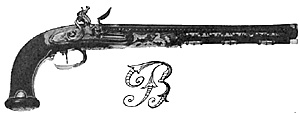QUESTION 8-1:
 I own a large boxlock French
flintlock multi-barrel pistol with octagonal
barrels signed by Lelyon. Lelyon was a
master gunmaker at Versailles from 1812 to
1817, i.e., during the latter part of the reign
of Napoleon Bonaparte. During that period
Lelyon would have worked under the most
famous of all French gunmakers, Boutet,
personal arms maker to Napoleon.
I own a large boxlock French
flintlock multi-barrel pistol with octagonal
barrels signed by Lelyon. Lelyon was a
master gunmaker at Versailles from 1812 to
1817, i.e., during the latter part of the reign
of Napoleon Bonaparte. During that period
Lelyon would have worked under the most
famous of all French gunmakers, Boutet,
personal arms maker to Napoleon.
The pistol is decorated with gold inlaid stars on the flats of the barrels. There are a total of 346 stars. On a set of pistols made for Napoleon by Boutet to commemorate the Egyptian Campaign, the barrel flats total 291 gold inlaid stars. The stars look exactly like the ones on my piece. What is the significance of the stars?
My Lelyon pistol also has a fancy script letter "B" measuring 3/8" wide by 1/2" high (see sketch). The letter is located on the brass boxlock frame underside, just forward of the trigger.
Could this letter "B" stand for Bonaparte? Wasn't it usual for personal arms of Napoleon to be engraved with the letter "N" surrounded by a wreath? If this is the case, then was this pistol made for one of Napoleon's relatives in high office using the "B" for Bonaparte to distinguish it from Napoleon? Or, was it given to Boutet by Lelyon?
The presence of the stars and the idea that Lelyon was at Versailles makes me believe that my pistol was made for Napoleon or for one of his royal relatives. I have written to various museums and to Versailles and received only confirmation that Lelyon was a master gunmaker at Versailles between 1812 and 1817. Other than that they have no further information.
Can the staff or your readers help me? - Mr. Reinhold C. Ferster
PARTIAL ANSWERS TO MULTIPART QUESTION 8~1: (EE&L staff)
The above questions are very difficult to answer. However, we can offer the following and hope a reader who is a collector can help with the unanswered parts.
1. This is most likely a dueling pistol. In the latter part of the 18th Century the pistol had almost completely replaced the sword as a dueling weapon, in England as well as in France. The major exception to this was in France where the military, especially the cavalry, continued to duel with the saber.
2. The main features common to all dueling pistols were the workmanship and materials. Among both the English and French this ranged from excellent to superlative. No inferior standards were tolerated by the clientele. Dueling pistols were crafted with the greatest care. The French, mechanically speaking, were on a par with the English, but the French put the English to shame for elegance and macabre grace.
3. In France, dueling pistols usually came in pairs in fancy boxes with countered recesses and were made to order by the gunsmiths. Lelyon was one of the many French gunsmiths of the period working at Versailles under the supervision of the Master Gunsmith Director-Designer Nicholas Noel Boutet.
4. Hexagonal gun barrels were standard for high grade dueling pistols manufactured at Versailles.
5. Decoratively carved, highly ornate pistols with silver or gold inlaid were never intended for the duel. It appears that gold inlaid stars were one of the favorite decorative motives, but any significance for the use of the stars is not known. Thousands of magnificently decorated so-called dueling pistols were made in France during the First Empire and were never intended to be used for anything but show. They were presented to important people, to royalty, and to retiring officers. The pistol shown here is such a dueling weapon made around 1805- 1810 at the Versailles manufacture under the supervision of Director-Designer Nicholas Noel Boutet.
6. We have no explanation for the "B." If the weapon was made between 1812 and 1815, it's unlikely that it was made for one of the Bonapartes. Jerome was King of Wesphalia until late 1813. Joseph was King of Spain. Louis, the ex- King of Holland, was more or less in exile in Italy, and Lucien was interned in England until he became reconciled with Napoleon in 1814.
The pistol owned by Mr. Ferster could be one the many thousands made during the period and most likely was made to order for an unknown Mr. "B."
We'll probably never know his name unless we find a list of recipients of these fancy pistols manufactured at Versailles.
Sources:
Held, Robert, The Age of Firearms, Bonanza Books, New York, 1957.
Misc. notes too numerous to be quoted here.
Back to Empire, Eagles, & Lions Table of Contents Vol. 2 No. 8
Back to EEL List of Issues
Back to MagWeb Master Magazine List
© Copyright 1994 by Emperor's Headquarters
This article appears in MagWeb (Magazine Web) on the Internet World Wide Web.
Other military history articles and gaming articles are available at http://www.magweb.com
